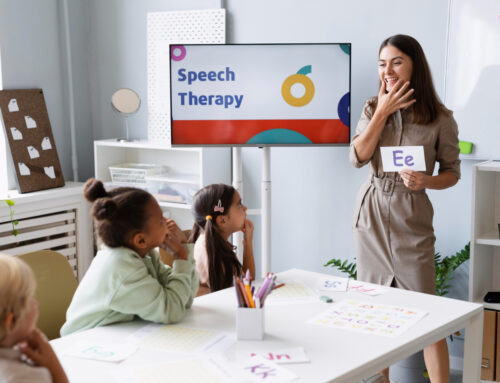
Books can be a wonderful way to help support your child’s speech language development. Reading to your child, even if you feel they aren’t paying full attention to the story, helps foster language and literacy skills while building vocabulary and joint attention. Books that offer repetitive sentence patterns on each page help improve speech automaticity, while rhyming books help increase phonemic awareness. Here are a few tips to help you use books to support your child’s speech/language development.
Read to your child every day.
Studies show the benefits of reading to your child 20 minutes a day to be numerous. If your child is unable to sit for 20 minutes, read a story aloud while they are preoccupied with another activity, such as floor play or in the bathtub. Just hearing the language, words, inflection, and story will help support their speech/language development.
Choose books according to your child’s developmental level, attention span, and preferences; not their chronological age.
If your child has a short attention span for reading activities, choose books with vibrant pictures, but less words per page, or shorten the story to fit their attention span. It is better to praise a child for sitting for 2 minutes (even if that meant you skipped pages), than to have both parent and child feel frustration by the end. Children with special needs, like any children, have “favorites”. Reading time will go smoother, if your child is able to incorporate their preferences when picking books to read. For me, this meant I read “Thomas the Tank Engine” books for what seemed like forever, but I would just remind myself “Literacy…any way I can get it”.
Acknowledge sensory needs before and during reading time.
When a child’s sensory needs are met, they are more equipped to pay attention; for example, sitting in a bean bag during reading time can provide a child more grounding sensory input than sitting in a chair where their feet do not touch the floor. Doing reading following a gross motor activity, such as pushing a laundry basket filled with clothes or giving receiving bear hugs, can also improve attention. Other ideas to help meet sensory needs during reading time are using a weighted lap blanket, allowing your child to wrap themselves up in a blanket, or giving them a squishy ball to squeeze.
Vocabulary Building
Sometimes, reading time with a younger child may mean pointing at different pictures on the pages and labeling them for your child. This is a wonderful way to help your child learn new words while still practicing joint attention to the book and its pictures. For a child who has words (or signs), you can point to the picture and ask them to tell you the name. Receptively, asking your child “Where is the ____” and having them locate the corresponding picture via pointing helps build receptive vocabulary and comprehension.
Choose books without pictures sometimes.
While vibrant picture books are wonderful choices to help gain and keep your child’s attention, it is also important to read stories without pictures. Reading stories without pictures allows your child to use their own imagination to picture the main character, setting, and events of the story as they “see” them, as opposed to the book’s illustrator. If your child is new to stories without pictures, choose short rhyming stories or even poems.
Inferencing Happens
When we make an inference, we take clues from text or pictures plus background knowledge to make an assumption of what has happened or what is happening. You can build your child’s inferencing skills during reading time by asking questions such as “I wonder what is going to happen next?”, “I wonder what (character) will do now?” or “I wonder how that made (character) feel?”.
Fun with sounds
Books with rhymes or strong alliteration patterns are fun to listen to! This is why “Cat in the Hat” books are so popular. But books can also be used to support a child’s speech sound practice/therapy. For example, if your child is working on the /r/ sound, then reading aloud books such as “Little Red Riding Hood” or “Rotten Ralph” provide examples of the target sound throughout the reading time, which will indirectly support your child’s progress towards making the sound correctly themselves.
Support Social Skills
Social skills can be indirectly introduced, taught, and reinforced through reading time stories (“How Do Dinosaurs Eat their Food” was a favorite with my boys when working on table manners.) In fact, through books, you can teach and reinforce everything from saying please (Please, Mr. Panda), how to make friends (“Peanut Butter and Cupcake”) to fire safety (No Dragons for Tea). For older children, the characters in books can demonstrate the characteristic of empathy, and teach consequences of action in a safe and positive framework.
Be Silly.
Being silly during reading time (making different character’s voices, over emphasizing inflection) is a great way to increase your child’s engagement in the story. Over emphasizing inflection helps support the acknowledgement of tone of voice and their different meanings which many children with special needs have difficulty understanding. This also helps show your child that reading can be fun and not a chore; a life skill that will continue to serve them through their school years.
I hope these suggestions have given you some ideas on how you can support your child’s speech/language skills during reading time, while making it go more smoothly for those of you with younger children.

 Katie Sullivan, M.S., SLP-CCC has been a pediatric Speech Language Pathologist for 22 years, and is a Therapy Supervisor with Theracare. She is the mother to five children, ages 7-17, including twin teenage sons with special needs. You can follow her at the My Sweet Homeschool blog, facebook, twitter, and instagram.
Katie Sullivan, M.S., SLP-CCC has been a pediatric Speech Language Pathologist for 22 years, and is a Therapy Supervisor with Theracare. She is the mother to five children, ages 7-17, including twin teenage sons with special needs. You can follow her at the My Sweet Homeschool blog, facebook, twitter, and instagram.





